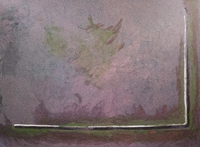Cora Kelly Ward
1970s
Acrylic on canvas
77 in. x 54 in.
Gift of Leonard Bocour
Cora Kelley Ward (1920-1989) was a Louisiana-born artist and photographer, who took part in the Abstract Expressionist movement during the 60s and 70s. She studied at the famous Black Mountain College, an arts school in Asheville, North Carolina, under Josef Albers (1888-1976) and Clement Greenberg (1909-1994).1 Ward was known throughout art circles in New York not only for her paintings, but also for her superb photography skills. Described as a formalist, her work focuses on the compositional elements of her images, such as color, line, and texture, and has little to no iconography or social context. Her paintings suggest emotions and memories, and, to Ward, were the answers and solutions to self-imposed questions and challenges in her own life.2
The Fine Arts Collection at St. Mary’s holds several works by Ward, including the painting Warning, a large-scale work done in acrylic paint. The primary colors emphasized are purple, green, and red hues, with hints of blues peeking out from underneath the layers. The most distinctive feature that draws the eye is a strip of black and white that forms a right angle, framing the painting on the right side. Although the line is not particularly jarring or harsh, it looks to have been painted with two long, nearly unbroken strokes, one in black and one in white, making it clearly distinct in pattern and texture from the rest of the painting. The lines over a blended background seem to be a recurring theme in Ward’s work throughout her career as an artist, and can be found in most of her pieces.3 It can be assumed that this was brought into the St. Mary’s collection by Leonard Bocour; although no official documentation can be found on its purchase and transportation. Bocour donated several other paintings by Ward to institutions around the country, such as Note 4 and Tom’s Point.5
Working in an abstract vocabulary, Ward was also aware of the Color Field movement, as it came about during her lifetime and was taught at Black Mountain College.6 The deliberate rejection of art styles of the past is apparent in her work, but not nearly as blatantly as some other artists. Ward is more experimental than defiant, thoughtfully swirling and dragging her brush, creating many layers of color and building up her image until it answered some unknown question in her soul. Warning is just such a painting, as only Ward herself likely knows the true meaning behind the name, and what personal message she has encoded into the layers of this work. Even though her work is impressive, there is still much work to be done by historians, as even though she worked in circles with influential people, her work as an abstract expressionist artist is still relatively unknown.
1. Jay Risher, “Second Life,” Country Roads Magazine, last modified April 27, 2015, http://countryroadsmagazine.com/art-and-culture/visual-performing-arts/cora-kelley-ward-artist/ ↩
2. Robin Miller, “Cora Kelley Ward,” geni.com, last modified September 17, 2012, https://www.geni.com/people/CORA-KELLEY-WARD/6000000007848642300↩
3. Mark Tullos, “Tale of Two Seekers,” Object and Idea, last modified June 21, 2012, http://objectandidea.blogspot.com/2012/06/tale-of-two-seekers.html ↩
4. “Note,” Weatherspoon Art Museum, http://weatherspoon.uncg.edu/collections/show?id=3486↩
5. “Tom’s Point,” Princeton University Art Museum, http://artmuseum.princeton.edu/collections/objects/31556↩
6. Risher, “Second Life.”↩
-Natalie Krissoff

